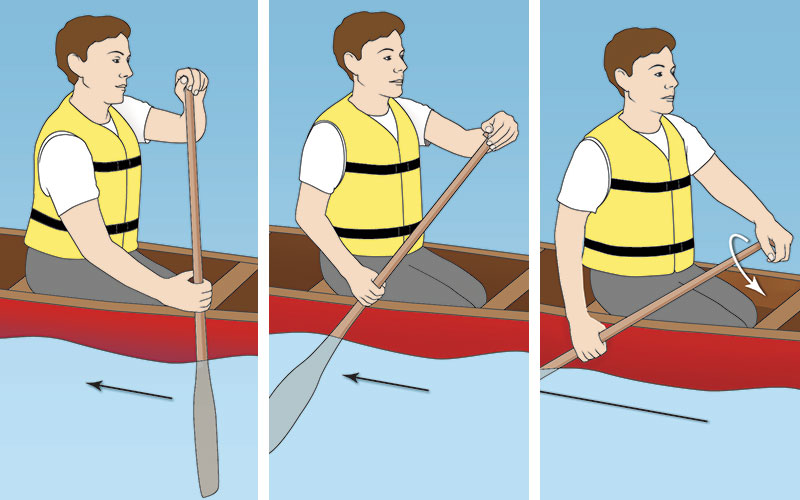

The J stroke, one of five essential canoe paddle strokes, begins with a forward pull and finishes with a quick “J” swirl.
There’s something satisfying about the J stroke. The subtle nature of it, how just a small turn of your wrist can provide gentle course correction and keep the boat pointed in the right direction. It’s efficient too, and that can help ensure long, enjoyable days on the water. The J, and four other strokes outlined below, are the foundation to almost any canoe adventure and can be mastered with a little practice.
1. Forward Stroke
The fundamental stroke, this maneuver propels the canoe forward. It’s a simple stroke—one repeated more than any other—but it is often done improperly. Chris Viani, a paddling trip leader for AMC’s New York-North Jersey Chapter, says he yells “vertical paddle” across the water dozens of times during an outing. “You want the paddle to be vertical or close to vertical. You want your grip hand to be out over the water,” Viani says.
The grip hand, the hand at the top of your paddle shaft, should also be at about eye level. The power comes not from your arms, but from your torso. To achieve this, Viani recommends rotating the shoulder on your paddle side forward, planting the paddle, and then rotating your shoulder back. Your arms should engage only briefly at the end of the stroke, as you recover and bring the paddle forward again.
2. Draw Stroke
Described as “one of your most powerful turning strokes” by Viani, the draw is something the front, or solo, paddler can employ to move the boat sideways or change direction. It’s done “onside,” the same side that you are already paddling on, which eliminates the need to repeatedly switch sides.
To execute, turn to face the stroke. “You reach out over the water,” Viani explains, “plant the paddle and essentially you pull the boat toward the paddle.” To recover, turn the blade perpendicular to the boat and slice it away from you, or lift the blade out of the water, and repeat the stroke.
3. Cross Draw Stroke
Designed for the front paddler, the cross draw is like the draw stroke but done on the opposite, or “off,” side than you are paddling on. If you want to turn the boat right, for example, and you are paddling on the left, maintain the same grip, withdraw the paddle from the water, fully rotate your torso, and execute the draw on the opposite side.
4. Stern Pry Stroke
The opposite of the draw stroke, the stern pry comes at the end of a forward stroke and brings the boat toward the paddle side. It’s a powerful turning stroke but can slow the boat down, so it’s important to execute quickly.
As you end the forward stroke, turn your torso toward the water. Your grip hand should be over the canoe’s gunwale and your shaft hand at waist level, slightly behind you, and parallel to the boat. The blade should be against the back of the boat. Quickly pry the blade outward by pulling in your grip hand.
5. J Stroke
“When you’re paddling in tandem,” Viani says, “there’s always that tendency for the boat to turn a bit to the stern paddler’s off side.” The J stroke, he adds, “[is] for minor corrections to keep the boat on the straight path.”
Used by the stern paddler, the J stroke is also added near the end of a forward stroke. As your arms come backward, rotate your grip hand forward and down, so that your thumb is pointed downward and push your bottom arm slightly outward to complete a quick “J” in the water, gently nudging the boat back toward the paddle.